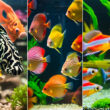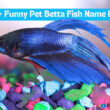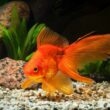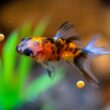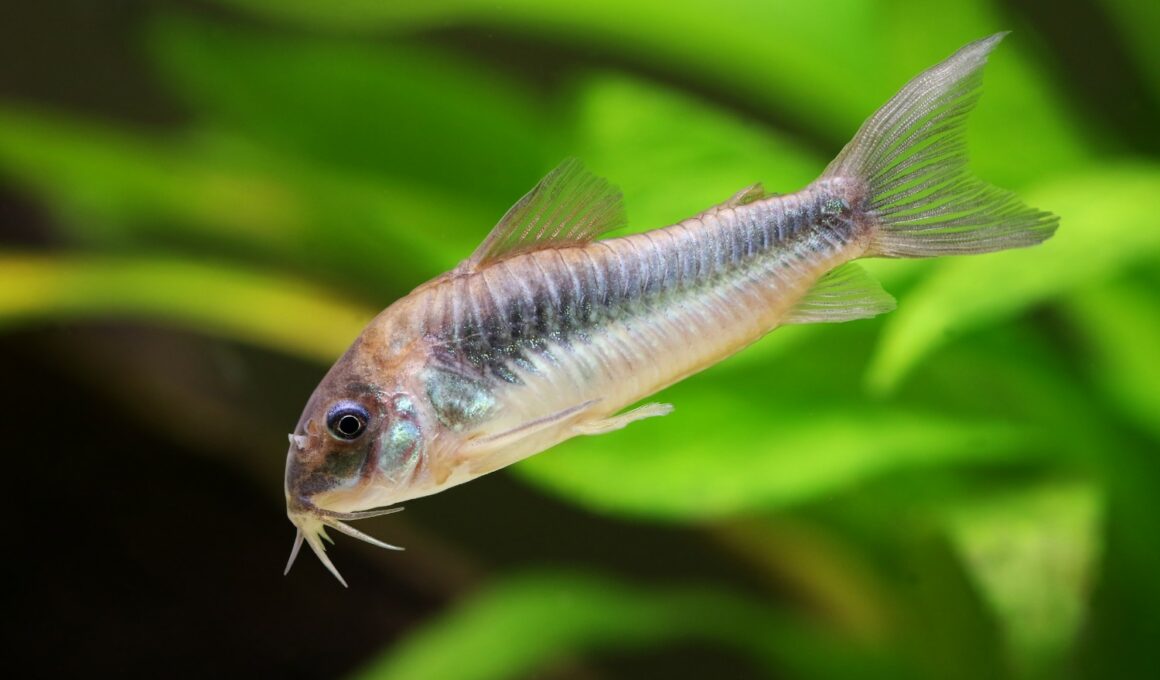In this article Show
As an avid fishkeeper, I’ve learned over the years that creating a harmonious tank environment isn’t just about aesthetics—it’s an art. Central to this art is choosing the right companions for your fish.
This brings us to our spotlight: catfish. These remarkable bottom dwellers, with their whiskered faces and calm demeanor, are a favorite in many aquariums. But who should be their tank buddies?
Now let’s explore the best catfish tank mates and ensure that your underwater community thrives in unity. Whether you’re a seasoned aquarist or just starting out, this guide is designed to offer clarity, ensuring your catfish have neighbors they’ll appreciate.
Understanding Catfish Behavior
Catfish are an incredibly diverse group of fish, with over 3,000 known species scattered across the globe. But despite this diversity, certain behavioral traits are commonly observed in many catfish species, especially those kept in home aquariums.
Different Species and Their General Behavior
Bottom Dwellers
Most catfish are bottom dwellers, which means they prefer spending the majority of their time at the bottom of the tank. They sift through the substrate (the material at the bottom of your tank like sand or gravel) looking for food using their barbels or “whiskers.”
Nocturnal Nature
Many catfish species are nocturnal, meaning they’re most active during the night. If you find your catfish hiding during the day, don’t be alarmed. Once the lights go off, they often come out to explore, forage, and play.
Given these general behaviors, it’s evident that catfish need a particular type of environment to feel at home.
The Need for a Peaceful Tank Environment
Catfish aren’t built for aggressive environments. Their calm and somewhat reserved nature means they flourish best in peaceful surroundings.
With their nocturnal habits, they prefer dimly lit or shaded areas, complemented by hiding spots like caves or dense plants where they can retreat during daylight hours.
When you introduce other species into a catfish tank, it’s essential to consider these behaviors. Fish that are too boisterous or that frequently disturb the bottom can stress out your catfish, impacting their health and happiness.
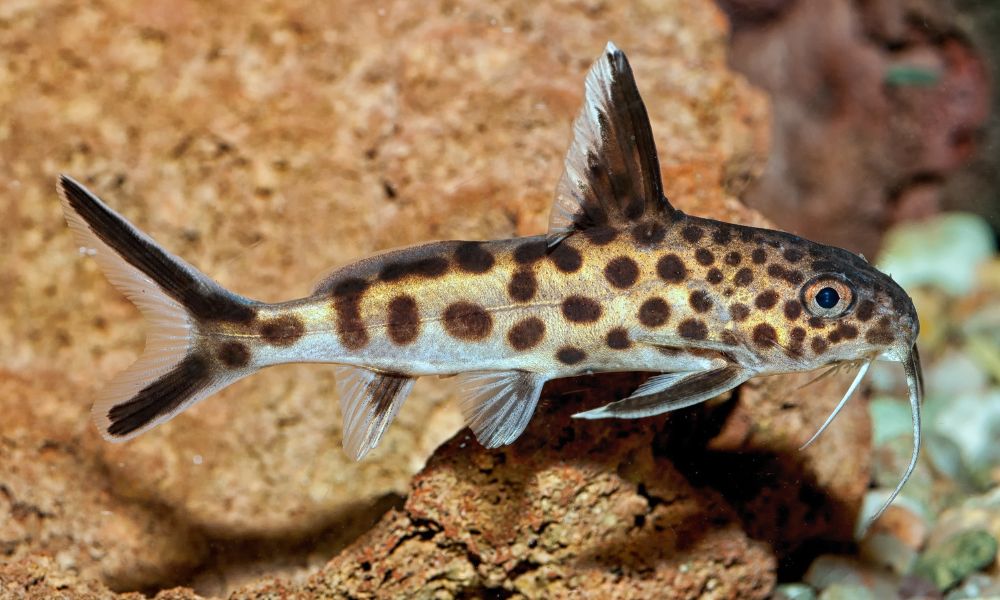
Ideal Water Conditions for Catfish
Just as we humans thrive best in comfortable living conditions, catfish, like all aquarium residents, have specific preferences when it comes to their watery home. Ensuring optimal water parameters isn’t just a good-to-have; it’s imperative for their health and longevity.
1. pH, Temperature, and Hardness Preferences
pH Level
Most catfish species, especially the common ones kept in home aquariums, prefer a pH level ranging from 6.0 to 8.0. This slightly acidic to slightly alkaline range mimics the natural water conditions they’d experience in the wild.
Temperature
Catfish are tropical to subtropical species, and thus they appreciate warm waters. The ideal temperature range for most catfish species lies between 72°F (22°C) and 82°F (28°C). It’s worth noting, however, that specific requirements might vary depending on the species, so always check the needs of the exact type of catfish you have.
Hardness
Generally, catfish are quite adaptable when it comes to water hardness. But, as a rule of thumb, they tend to thrive in soft to moderately hard water. This translates to a dGH (degree of General Hardness) range of 4-15 for most species.
2. Importance of Maintaining Stable Conditions For Community Tanks
Stability is the keyword when it comes to aquariums. Rapid changes, whether in pH, temperature, or hardness, can cause stress to fish, making them susceptible to diseases. This is even more crucial in a mixed species tank where the needs of different fish have to be harmonized.
For catfish sharing their home with other species, consistent water parameters are essential to prevent conflicts and ensure all inhabitants remain healthy. Regular water testing and monitoring can help detect any discrepancies before they become problematic.
Moreover, when considering tank mates for catfish, it’s wise to choose species with similar water condition requirements. This not only ensures a harmonious environment but also simplifies the maintenance routine for the aquarist.
10 Best Catfish Tank Mates
When it comes to choosing tank mates for your catfish, it’s essential to consider species that won’t just coexist but will thrive together. One of the best choices in this regard is the colorful and lively Tetras.
1. Tetras
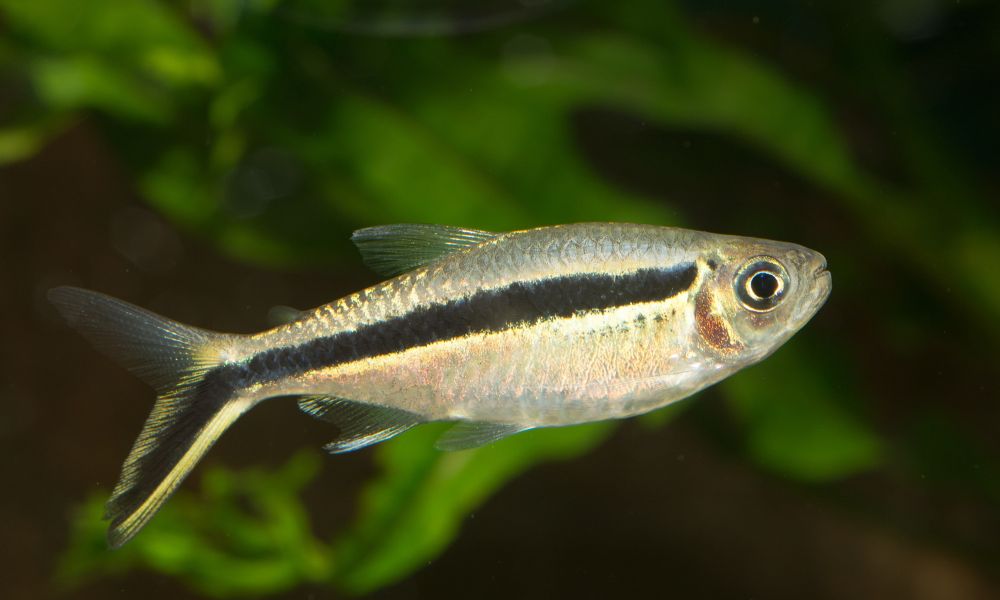
| Characteristics | Tetras (Neon Tetras, Cardinal Tetras) |
| Size | 1 to 2 inches (2.5 to 5 cm) |
| Diet | Omnivore |
| Temperament | Peaceful |
| Care Level | Easy to Intermediate |
| Minimum Tank Size | 10 gallons (38 liters) |
Tetras are generally peaceful fish, which makes them perfect tank mates for the equally calm catfish. They don’t show aggressive tendencies, ensuring a serene tank environment.
While catfish are bottom dwellers, Tetras mostly swim in the middle to upper parts of the tank. This means both species have their own space, reducing competition and potential conflict.
Tetras and catfish share similar water condition preferences, particularly when it comes to pH and temperature. This makes it easier to create a stable environment for both.
The bright and shimmering colors of Tetras, especially species like Neon and Cardinal Tetras, provide a beautiful contrast to the more subdued hues of catfish. This creates a visually appealing tank with vibrant activity at multiple levels.
2. Loaches
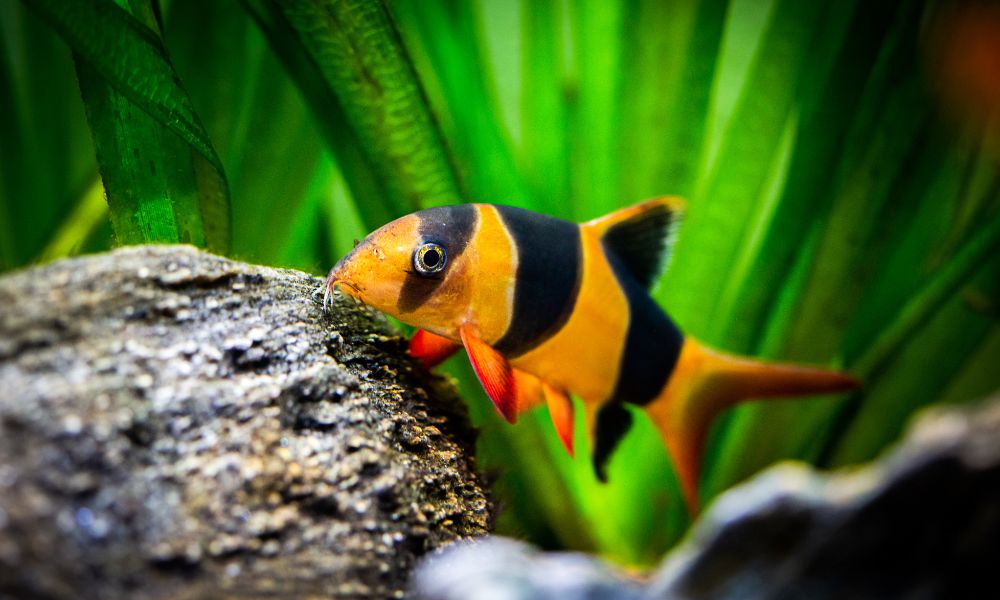
| Characteristics | Loaches (Clown Loach, Kuhli Loach) |
| Size | Peaceful to Semi-aggressive (species-dependent) |
| Diet | Omnivore |
| Temperament | Peaceful to Semi-aggressive (species dependent) |
| Care Level | Intermediate |
| Minimum Tank Size | 30 gallons (115 liters) |
Like catfish, many loach species are bottom dwellers. They often enjoy sifting through the substrate, much like catfish. This shared behavior can sometimes lead to playful interactions between the two.
Most loaches, especially the popular Clown and Kuhli Loaches, are generally peaceful and get along well with catfish. However, given their bottom-dwelling habits, it’s crucial to provide enough hiding spots and space to prevent territorial disputes.
Both catfish and loaches are omnivores, which means they have similar dietary needs. This makes feeding a mixed tank of catfish and loaches relatively straightforward, although care should be taken to ensure all fish get their share of food.
Loaches, like catfish, have a scaleless body, making them more susceptible to certain diseases. While this means you need to be extra careful about water conditions, it also means they have similar care requirements, simplifying overall tank maintenance.
Many loach species are quite social and prefer to be in groups. This, combined with the generally social nature of catfish, creates a lively bottom-of-the-tank environment.
3. Cories
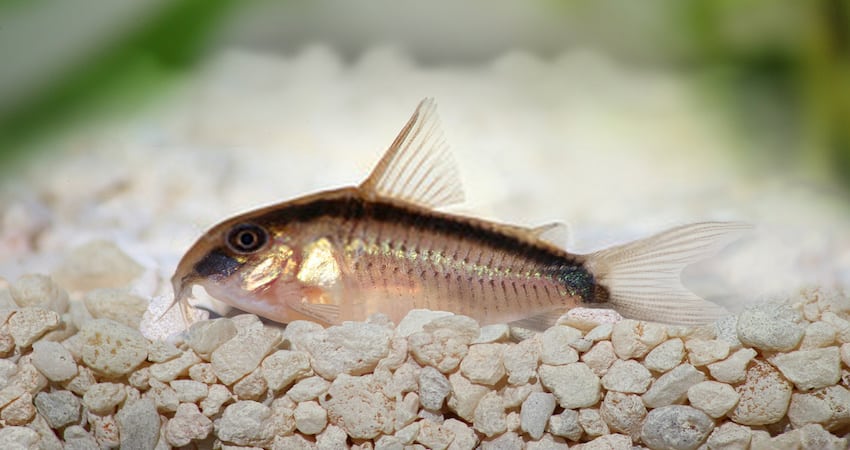
| Characteristics | Corydoras (Various Species) |
| Size | 1 to 3 inches (2.5 to 7.5 cm) |
| Diet | Omnivore |
| Temperament | Peaceful |
| Care Level | Easy |
| Minimum Tank Size | 20 gallons (75 liters) |
Corydoras, affectionately known as Cories, come in a myriad of species, each with its unique color pattern and size. Cories are continuously on the move, sifting through the substrate in search of food. Their whisker-like barbels help them detect food particles in the sand or gravel.
Not only are Cories peaceful, but they’re also highly social creatures. They thrive best in shoals and can often be seen swimming together or resting side by side.
While they’re not particularly aggressive, Cories are territorial, much like catfish. Having a spacious tank with plenty of hiding spots (like caves or dense plants) ensures each fish has its own little haven.
Given their peaceful nature and similar bottom-dwelling habits, Cories get along well with most catfish species. They can often be seen coexisting and foraging together, creating an active and harmonious bottom layer in the tank.
4. Plecostomus (Plecos)
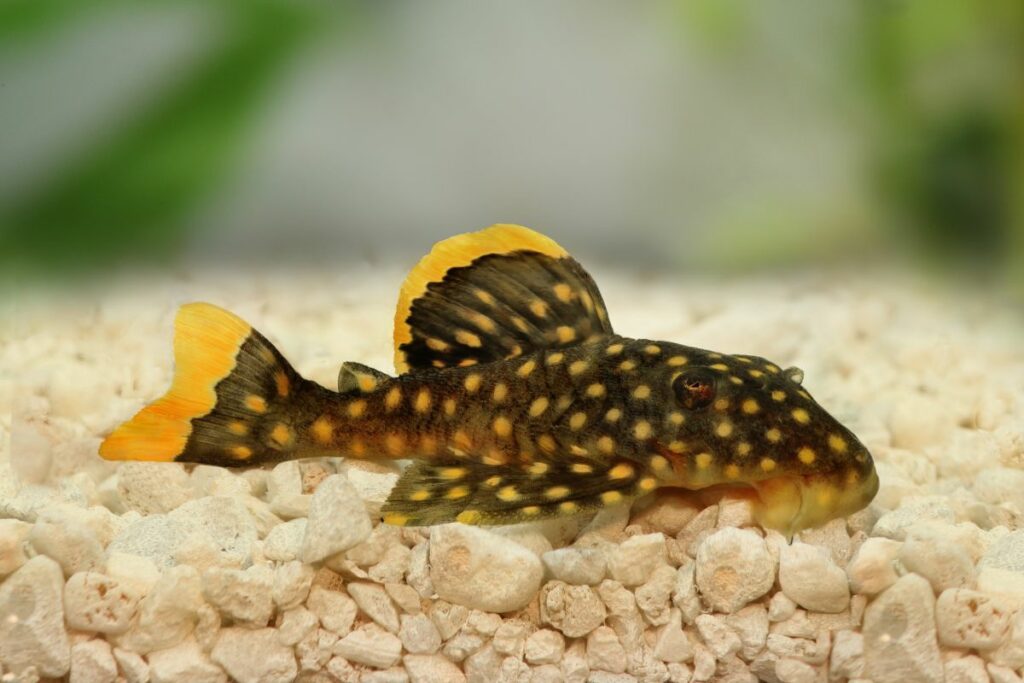
| Characteristics | Plecostomus |
| Size | 5 to 24 inches (13 to 61 cm) |
| Diet | Herbivore to Omnivore (species dependent) |
| Temperament | Peaceful to Semi-aggressive |
| Care Level | Intermediate to Advanced |
| Minimum Tank Size | 30 to 150 gallons (115 to 570 liters) |
Plecos, or Plecostomus, represent a vast group of species, each bringing a unique appearance and size to the table. Here are some commonly kept types:
- Common Pleco: Often seen in pet stores, they can grow quite large and are known for their hearty appetite for algae.
- Bristlenose Pleco: A smaller species characterized by tentacle-like whiskers on their snouts.
- Sailfin Pleco: Recognizable by their large dorsal fins, they can be a bit more demanding in care.
- Clown Pleco: A smaller, wood-eating species with striking patterns.
- Zebra Pleco: Prized for its beautiful black and white striped pattern.
Many Pleco species are voracious algae eaters, helping to naturally reduce and control unwanted algae growth in the tank.
Like catfish, Plecos often scour the substrate, feeding on detritus and keeping the tank’s bottom layers cleaner. This combined action of catfish and Plecos ensures a tidier tank with reduced organic waste.
While both catfish and Plecos are bottom dwellers, they often have different feeding niches. Catfish typically sift through the substrate, looking for bits of food, while Plecos tend to focus on algae-covered surfaces and wood.
Given the potential size of some Pleco species, it’s essential to ensure that the tank is spacious enough for both catfish and Plecos to coexist without crowding.
5. Rasboras
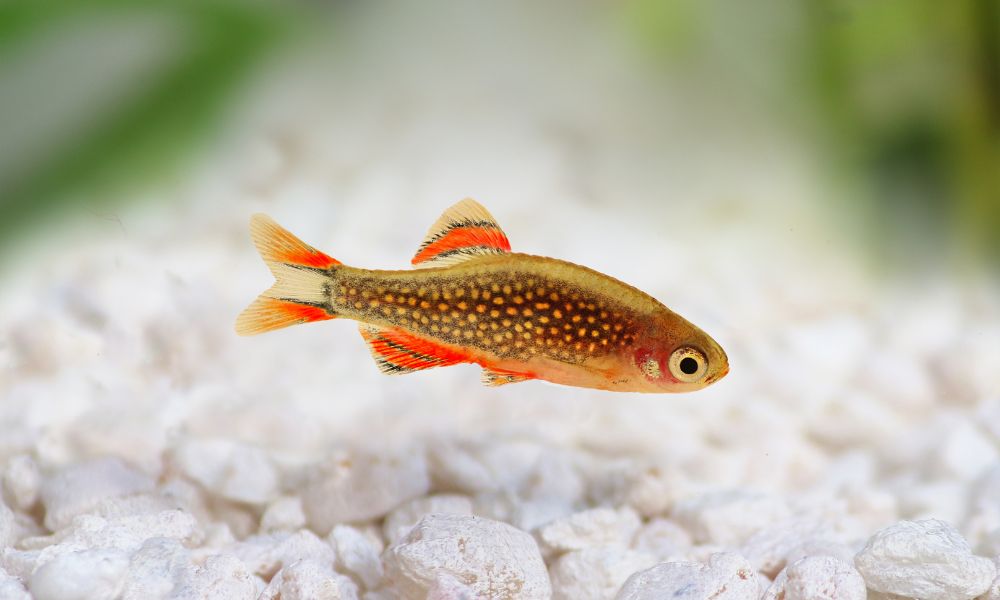
| Characteristics | Rasboras |
| Size | 0.5 to 2 inches (1.3 to 5 cm) |
| Diet | Omnivore |
| Temperament | Peaceful |
| Care Level | Easy |
| Minimum Tank Size | 10 gallons (38 liters) |
Rasboras are a group of small, vibrantly colored freshwater fish that add a dash of brilliance to any aquarium. Some of the popular types include:
- Harlequin Rasbora: Recognized by its distinct orange body and black triangular patch, it’s one of the most popular Rasbora species.
- Galaxy Rasbora also known as Celestial Pearl Danio: A tiny, jewel-like fish adorned with starry spots and brilliant colors.
- Scissortail Rasbora: Named for its forked tail that resembles an open pair of scissors.
- Lambchop Rasbora: Similar to the Harlequin but with a thinner body and more delicate appearance.
Rasboras are known for their peaceful nature. They do not show aggressive tendencies, making them perfect neighbors for the similarly calm catfish.
While catfish are primarily bottom dwellers, Rasboras are mid-to-upper-level swimmers. This distinct layering ensures minimal territorial disputes and creates a dynamic visual contrast in the tank.
Rasboras prefer to swim in groups, creating stunning synchronized displays. Their schooling nature and vibrant colors make them a visual highlight in any aquarium.
Rasboras and catfish share comparable water condition preferences, which facilitates the maintenance of a stable environment conducive to both species.
6. Other Catfish
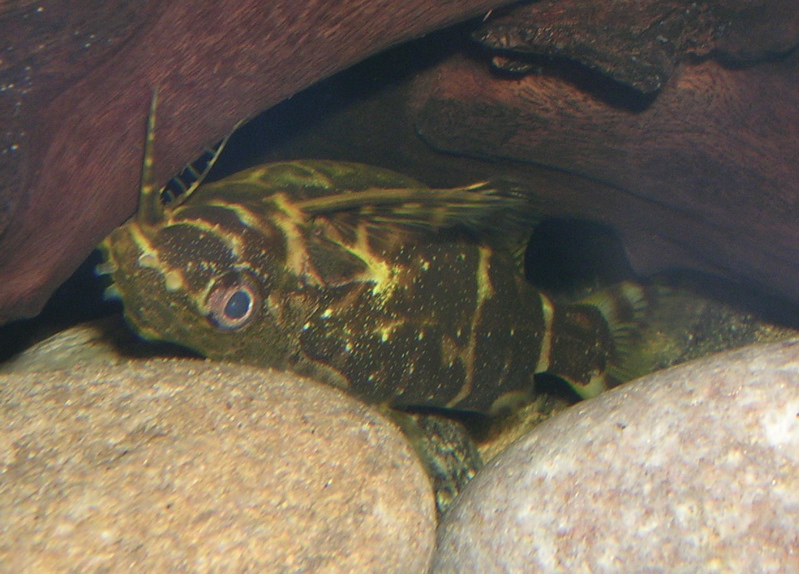
| Characteristics | Other Catfish |
| Size | 1 to 6 inches (2.5 to 15 cm) |
| Diet | Omnivore |
| Temperament | Peaceful |
| Care Level | Easy to Intermediate |
| Minimum Tank Size | 20 to 75 gallons (75 to 285 liters) |
While many aquarists are familiar with the common catfish species, there are numerous other fascinating catfish that can be added to a tank:
- Bristlenose Catfish: Characterized by tentacle-like bristles on their snouts, Bristlenose are relatively small and come in various colors, from albino to standard brown.
- Otocinclus Catfish: Often referred to as “Otos,” these tiny catfish are algae-eating machines. They have a slim body and are incredibly peaceful.
- Glass Catfish: As the name implies, these catfish are nearly transparent, offering a unique appearance in the tank.
- Upside-Down Catfish: Known for swimming in an upside-down position, these catfish add a quirky charm to any aquarium.
Most catfish species, especially the ones listed above, are known for their peaceful temperament. They can cohabit without major territorial disputes, especially in a well-decorated tank with ample hiding spots.
While all catfish species sift through the substrate, they often focus on different microhabitats or types of food, reducing competition and ensuring all species get their share.
Being of the same broader family, these catfish species generally have similar requirements in terms of water conditions, making tank maintenance simpler.
It’s always beneficial to ensure that each catfish species is introduced in appropriate groups, as some prefer the company of their own kind.
7. Shrimps
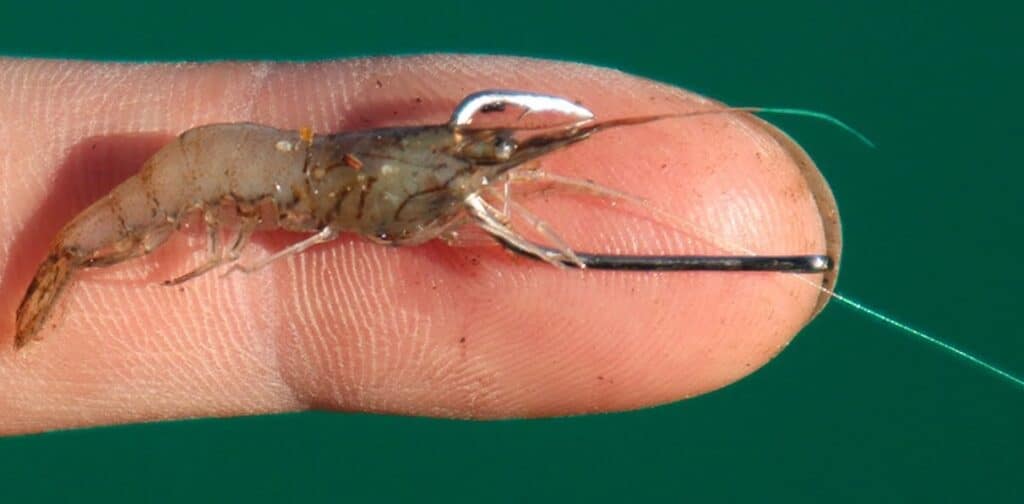
| Characteristics | Shrimp |
| Size | 0.5 to 2 inches (1.3 to 5 cm) |
| Diet | Omnivore (with a leaning towards herbivore) |
| Temperament | Peaceful |
| Care Level | Easy to Intermediate |
| Minimum Tank Size | 5 gallons (19 liters) |
Shrimps are nature’s little cleanup crew. They tirelessly scavenge the tank, consuming detritus, uneaten food, and algae. This not only helps in reducing waste but also ensures a cleaner substrate.
Many shrimp species, especially the Amano shrimp, are prolific algae eaters. They can help manage and reduce the growth of unwanted algae, keeping the tank’s plants and decorations looking pristine.
Due to their small size, shrimps have a minimal impact on the tank’s bioload. This means they don’t contribute significantly to the waste levels, making it easier to maintain water quality.
Shrimps have fascinating behaviors. Watching them forage, interact, and go about their daily routines can be a captivating and therapeutic experience for aquarists.
Given their peaceful nature, shrimps generally coexist well with catfish. However, it’s crucial to ensure the tank offers plenty of hiding spots for the shrimp, especially in the presence of larger catfish species.
Many hobbyists find joy in breeding shrimps, especially colorful varieties like the Cherry or Crystal Red shrimps. Their breeding can add a new layer of engagement and fascination to the tank.
8. Snails
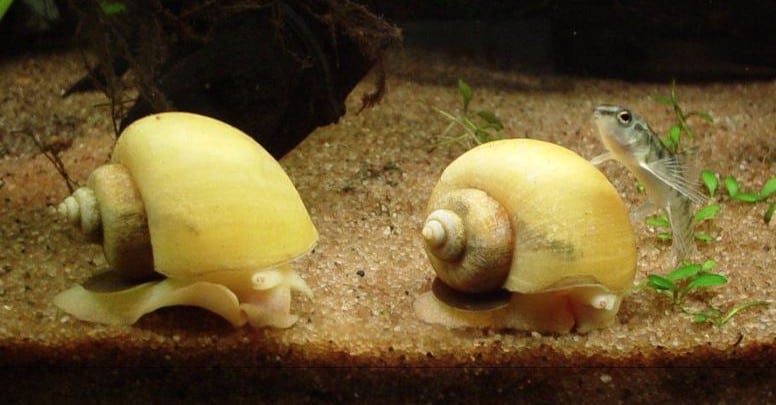
| Characteristics | Snails |
| Size | 0.25 to 3 inches (0.6 to 7.6 cm) |
| Diet | Omnivore (with a leaning towards herbivore) |
| Temperament | Peaceful |
| Care Level | Easy |
| Minimum Tank Size | 5 gallons (19 liters) |
One of the most appreciated benefits of snails is their appetite for algae. They can efficiently graze on the tank’s surfaces, plants, and decorations, removing unwanted algal growth.
Snails, with their slow but consistent movement, can help clean up detritus, uneaten food, and even decaying plant matter, contributing to a cleaner and healthier tank environment.
Some snail species, like Malaysian Trumpet Snails, burrow into the substrate. This burrowing behavior helps aerate the substrate, preventing harmful gas pockets and promoting root health for aquarium plants.
Snails, especially species like the Apple Snail or Nerite Snail, can be visually appealing. Their unique shells add an ornamental aspect to the aquarium.
Snails require minimal care. They are hardy creatures and adapt well to varying water conditions as long as sudden parameter changes are avoided. Snails and catfish coexist peacefully. The protective shell of the snail acts as a natural barrier against any curious catfish, ensuring both parties remain unharmed.
Snails can often act as indicators of the tank’s health. If snails are actively moving and feeding, it’s generally a good sign. However, if they remain closed up in their shells or float for prolonged periods, it might indicate issues with water quality.
9. Guppies
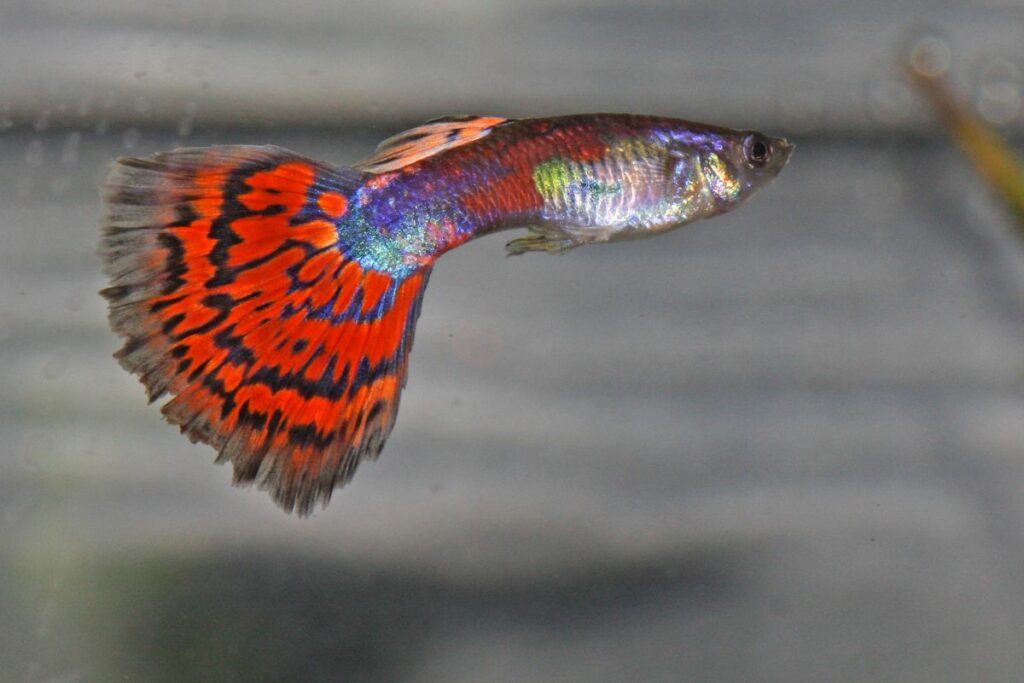
| Characteristics | Guppies |
| Size | 0.6 to 2.4 inches (1.5 to 6 cm) |
| Diet | Omnivore |
| Temperament | Peaceful |
| Care Level | Easy |
| Minimum Tank Size | 5 gallons (19 liters) |
Guppies, known for their vivid colors and playful nature, are one of the most popular freshwater fish among hobbyists. They come in a plethora of tail patterns and colorations, adding a vibrant splash to any aquarium.
Guppies are generally top to mid-level swimmers, ensuring they don’t intrude on the catfish’s bottom-dwelling territory. Guppies are livebearers and are known to breed easily, providing aquarists with the joy of witnessing the birth and growth of fry.
With their peaceful demeanor, guppies tend to get along well with catfish, ensuring a harmonious tank environment.
10. Dwarf Gouramis
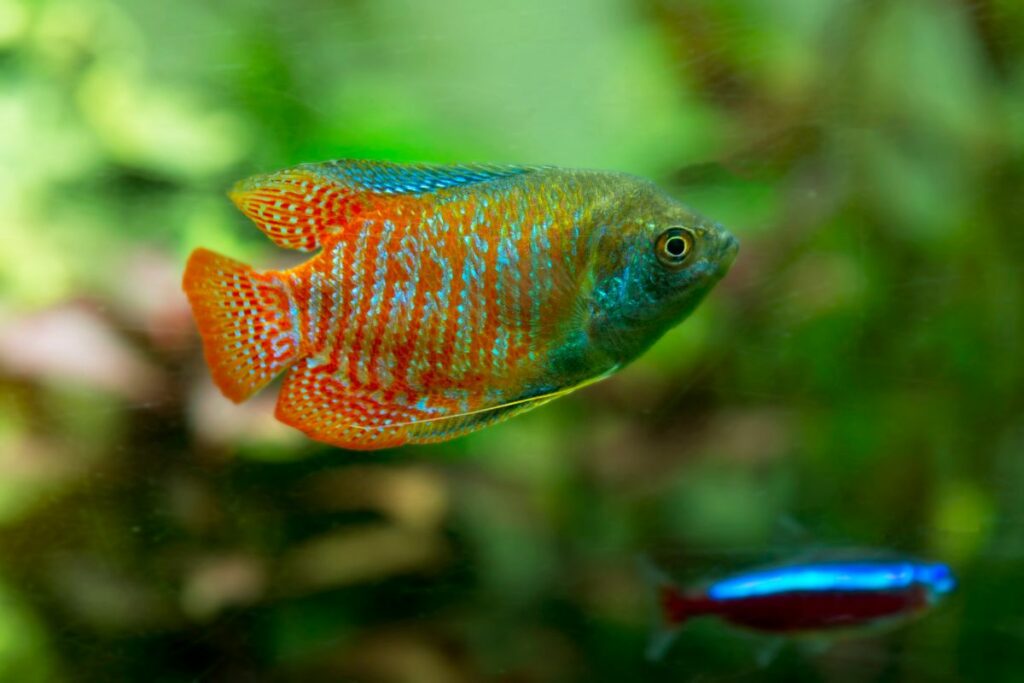
| Characteristics | Dwarf Gouramis |
| Size | 2 to 3.5 inches (5 to 9 cm) |
| Diet | Omnivore |
| Temperament | Peaceful |
| Care Level | Intermediate |
| Minimum Tank Size | 10 gallons (38 liters) |
Dwarf Gouramis are visually stunning fish, often characterized by their vibrant hues and calm disposition. They add both beauty and tranquility to the tank.
Dwarf Gouramis usually stick to the top and middle regions of the tank, ensuring there’s little conflict with bottom-dwelling catfish. The males have a unique behavior of building bubble nests at the water’s surface when they’re ready to breed, adding a layer of interest to the tank’s activities.
Their serene nature ensures they don’t disturb or threaten the catfish, making them an excellent choice for a multi-species tank.
Tank Mates to Avoid for Catfish
Choosing the right tank mates for your catfish is not just about finding species that gel well with them. It’s equally essential to identify and avoid those that can pose threats or create an incompatible environment. Here’s a breakdown of tank mates to sidestep:
1. Aggressive Fish Like Cichlids
While the Cichlid family comprises a wide variety of species, many of them are territorial and aggressive, particularly during breeding times. This aggression can stress out or even injure the generally peaceful catfish. For example:
- Oscar Fish: Known for their aggressive behavior and substantial size, Oscars can quickly turn smaller catfish into a meal.
- Jewel Cichlids: Their territorial nature can make the tank a stressful environment for catfish.
2. Species that Prefer Vastly Different Water Conditions
Maintaining stable and compatible water conditions is vital for the well-being of your fish. Introducing species that have drastically different requirements can lead to a challenging and unstable environment. For instance:
- Discus: While they’re peaceful, Discus require specific water conditions, particularly softer and more acidic water, which might not align with the needs of many catfish species.
- African Rift Lake Cichlids: These fish require hard, alkaline water, which contrasts the conditions preferred by many catfish species.
3. Species that Might See Catfish as Food
Larger predatory fish or those with a habit of nipping at fins and barbels can pose a direct threat to your catfish, especially if the catfish are of a smaller variety.
- Arowanas: Due to their large size and predatory nature, Arowanas can view smaller catfish as prey.
- Redtail Catfish: Ironically, another catfish species, but this giant can consume tank mates that fit into its mouth.
- Certain Puffers: Some pufferfish species have a tendency to nip at the fins of other fish, making them a potential threat to catfish.
Factors to Consider When Introducing New Tank Mates
When adding new inhabitants to your aquarium, it’s essential to ensure that the environment remains harmonious and conducive to the well-being of all its residents. Here are some key factors to keep in mind:
Size of the Tank
1. Space Requirements
Every fish species has specific space requirements, not just for swimming but also for establishing territories. A crowded tank can lead to stress, territorial disputes, and even health issues.
2. Biological Load
Apart from physical space, consider the biological load the new fish will add. More fish means more waste, which can impact water quality unless the filtration is adequate and water changes are consistent.
3. Growth Potential
Remember to account for the potential growth of the fish. A fish that’s small when purchased might grow significantly, necessitating more space than initially anticipated.
A Number of Hiding Spots
1. Territorial Needs
Many fish species are territorial and require their own “safe space” or hideaway. This is especially true for bottom-dwellers like catfish.
2. Stress Reduction
Hiding spots, such as caves, plants, or decorations, provide refuge for fish when they feel threatened or stressed, ensuring their well-being.
3. Breeding Considerations
If you have fish that breed in the tank, hiding spots become even more critical as they offer places for spawning or protection of fry.
Monitoring for Signs of Aggression or Stress
1. Initial Introduction
The first few hours to days after introducing new tank mates are crucial. Monitor the behavior of both the new arrivals and the existing inhabitants to ensure there’s no overt aggression or bullying.
2. Signs to Watch For
Look for chase behaviors, nipping, or cornering as indicators of aggression. On the flip side, if a fish is constantly hiding, has clamped fins, or exhibits rapid breathing, it could be a sign of stress.
3. Quarantine
Before introducing new fish to the main tank, it’s a good practice to keep them in a quarantine tank for a few weeks. This not only helps in identifying any illnesses but also allows the fish to acclimate to the new water conditions gradually.
4. Acclimation
Ensure a slow acclimation process for the new fish, especially when it comes to matching temperature, pH, and other water parameters.
Wrapping Up
In the world of aquarium keeping, ensuring harmony among tank inhabitants is paramount. Every fish species brings its unique behavior, needs, and charm to the aquatic environment.
By carefully choosing and introducing tank mates, monitoring their interactions, and providing a well-maintained habitat, aquarists can create a thriving underwater ecosystem where every resident coexists in balance and beauty.
Whether you’re a seasoned fish keeper or a novice, always prioritize the well-being of your aquatic pets, and in return, they’ll offer endless moments of wonder and tranquility.


